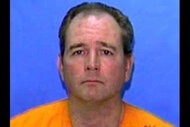Create a free profile to get unlimited access to exclusive videos, breaking news, sweepstakes, and more!
Why Did Danny Rolling, The Gainesville Ripper, Kill 5 Students — Ted Bundy, Personality Disorder Or Abuse?
Danny Rolling killed five students in Florida in 1990 — and his explanation for it included childhood abuse, multiple personalities, and Ted Bundy.
Danny Rolling was found guilty of all five murders he committed in quick succession in Gainesville, Florida near a university campus. He raped, mutilated, beheaded and posed his victims with precision and meticulousness.
Why did he do it? His explanation offered a mix of reasoning involving an outdated psychological diagnosis and his fellow serial killer, Ted Bundy, who he failed to eclipse in notoriety.
During his trial, his mother and ex-girlfriend pointed to a lifetime of abuse at the hands of his father, reports United Press International. The fear of his allegedly abusive father prevented his mother from leaving him — and scared Danny Rolling away from therapy. Rolling’s girlfriend testified that he didn’t seek care because, as he told her, “if my dad finds out what I said, he’ll kill me.”
Rolling himself tried to convince investigators that he had two personalities: the murderous Gemini, and Ynnad, a “Jesse James-type robber,” reported the Orlando Sentinel.
Just a few months before his murders in Gainesville, Rolling had fled Louisiana, after an attempt to murder his allegedly abusive father by shooting him in the stomach and face. At the time of his murder trial — which included testimony from his mother and others on his father’s alleged abuse — Danny Rolling was already serving life sentences for robbery and burglary.
But did his self-diagnosis of multiple personalities hold any water?
Harry Krop, a clinical psychologist in the area, had first examined Danny Rolling in January 1991 after he was arrested on armed robbery charges in nearby Ocala, reported the Orlando Sentinel. Rolling had an “incredible amount of underlying anger,” and a “borderline personality characterized by violent mood swings, impulsive and self-destructive behavior, narcissism and anti-social feelings,” but the psychologist presented no testimony of multiple personalities.
“Multiple personalities” were a bit of a fad at the time, especially after the release of the immensely popular book “Sybil” in 1973, and continue to endure in pop culture. From “The Three Faces Of Eve” (1957) to Primal Fear (1996) and Split (2016), the idea that there could be more than one person lurking beneath the epithelial surface is a compelling, if creepy, possibility.
Now known as dissociative disorders, this diagnosis has been mostly defanged. They were once “syndromes of the moment” in the recent past, according to a report by John F. Kihlstrom of University of California, Berkeley: for example, more than 500 cases had been admitted to a single dissociative disorder treatment unit in Dallas, Texas, between the years of 1991 and 1997.
But there was another facet to Rolling’s killings, especially the timing and choice of victims.
Ted Bundy, considered the most infamous of Florida serial killers, died by electric chair on January 24, 1989, less than two years before Danny Rolling went on his horrific spree in August, 1990. The media circus around the Bundy trial may have impacted its outcome, speculated Ted Bundy’s lawyer John Henry Browne.
But in a way, Bundy got what he wanted: infamy. And Rolling wanted some of that too.
Suspected in the death and disappearances of at least 36 women in the United States, Bundy struck a similar figure to Rolling’s, who was 36 when he killed Sonja Larson, 17, Christina Powell, 17, Christa Hoyt, 18, Tracy Paules, 23 and Manny Taboado, 23. They were all students: like the victims of the brutal Florida State University killings that Bundy was found guilty of. Like Bundy, Rolling too entered students’ private dwellings where he beat, assaulted and murdered his victims. Both men, born eight years apart, engaged in voyeurism and petty theft at a young age, crimes that would only become more serious with time, and apparently, both wrote songs and traveled the country.
Rolling, who initially pled not guilty, changed his plea to guilty on all counts, shocking audiences during his 1994 trial.
When he was brought to trial, Rolling confessed that he wanted to become a “superstar” like Ted Bundy. But he didn’t achieve that notoriety, explained state attorney Rod Smith to the Gainesville Sun, because of authorities’ efforts to focus on the victims and their families. While Bundy was charming, and had a normal life, Rolling had one marked by abuse and failure. Bundy was the object of infatuation and recipient of much fan mail, while Rolling never quite got there — though he did have a crime writer fiancée, while in prison.
On March 24, 1994, a unanimous jury found Rolling guilty on first-degree murder and other charges, and a month later, the circuit judge sentenced him to death. Rolling’s appeal was denied and his conviction and death sentences affirmed in 1998.
Rolling was executed by lethal injection on October 25, 2006, right after the Supreme Court declined to hear his appeal, making him the 63rd inmate to be put to death since Florida resumed executions in 1979, reported the Gainesville Sun. He sang gospel verses and supped on a lavish seafood dinner. He was 52 years old; 16 years older than he was when he killed his young victims.
Oxygen's “Mark of a Killer” delves into the psyches of serial killers with one-hour episodes focusing on their postmortem signatures. Watch the series now to find out how Danny Rolling became the Gainesville Ripper.
[Photo: Gainseville Police Department]

























